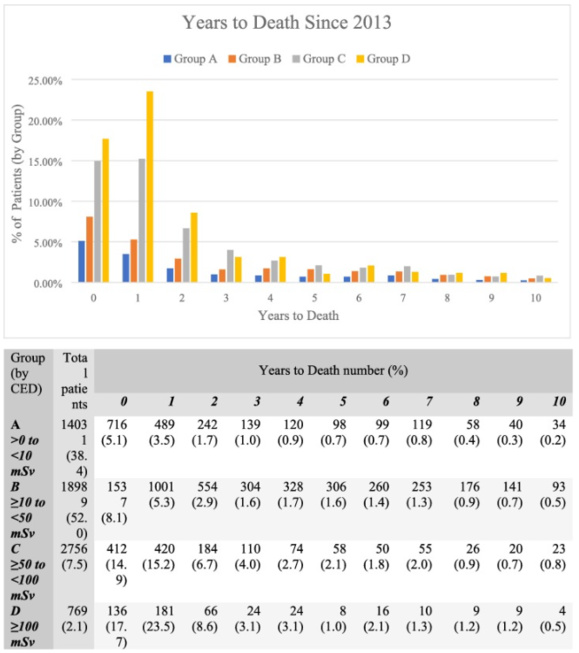What proportion of CT scan patients are alive or deceased after 10 years
A very interesting just published paper entitled “What proportion of CT scan patients are alive or deceased after 10 years?” by Maria T. Mataac, Xinhua Li, Madan M. Rehani in the European Journal of Radiology, https://doi.org/10.1016/j.ejrad.2024.111629, Volume 178, September 2024, challenges a commonly put forward assumption in healthcare: that patients receiving multiple CT scans are already very sick and likely to die soon, making radiation risk irrelevant. Researchers at Massachusetts General Hospital investigated this notion by analyzing the death rates for 10 years of patients who underwent one or more CT scans in 2013. They categorized patients in four dose groups: A (>0 to < 10 mSv), B (10 to < 50 mSv), C (50 to < 100 mSv), and D (≥100 mSv).
The findings revealed a more nuanced and educational picture than previously thought. While it's true that patients receiving higher doses (≥50 mSv) experienced a higher death rate within the first two years compared to those receiving lower doses, a significant portion of these patients defied the initial assumption. Here's the key takeaway:
• Nearly half (48.0%) of patients in the 50-100 mSv group were still alive after ten years, challenging the notion that those getting recurrent CT scans automatically translate to a short lifespan.
• Over a third (36.7%) of patients in the even higher dose group (≥100 mSv) also remained alive a decade later, rendering radiation protection worthwhile and necessary.
• Death rates for all dose groups peaked in the year of imaging or 1 year after. At one year after imaging, Group D had 6.7 times and Group C had 4.3 times the death rate of Group A.
The study acknowledges limitations, including its focus on a single hospital and the exclusion of radiation exposure from other sources like nuclear medicine exams or scans performed at other institutions. However, it serves as a valuable starting point for further research, particularly considering the sizable number of patients who survive for a considerable period after high-doses from multiple CT scans. The authors emphasize the need for continued efforts to strengthen radiation protection for patients undergoing CT scans, particularly those in the higher dose groups.
This study is not a cause analysis study but an observational study but makes us mindful about the possibility of long-term effects of radiation exposure on patients who survive a decade after multiple CT scans. Further, it paves the way for future research in this area. Given the substantial number of patients who live for ten years or more after high-dose scans, investigating the potential for radiation-induced cancers and other health complications becomes increasingly important.
Making patients undergoing multiple CT scan safer
The study's findings highlight the importance of attention to patients who undergo multiple CT scan in terms of justification and optimization of practices to balance diagnostic benefits with radiation risk. With the knowledge that a significant portion of patients receiving high doses through CT scans survive over a decade, where there are increased chances of cancer and non-cancer radiation effects, healthcare providers, imaging industry, and policy-making organizations need to develop new solutions in addition to standard guidelines stated below:
• Utilize clinical decision support systems to ensure the appropriateness of CT scans, minimizing unnecessary exposure.
• Explore alternative imaging techniques whenever possible, particularly for patients who may require multiple scans or fall into high-risk categories.
• Optimize scan protocols to minimize radiation dose while maintaining diagnostic quality.
• Communicate effectively with patients about potential radiation risks and benefits of CT scans, empowering them to participate in informed decision-making.
Conclusion
This study encourages a more nuanced approach to the discussion of CT scan radiation risks. While acknowledging the initial vulnerability of patients receiving higher doses, it underscores the importance of long-term radiation protection strategies considering the substantial number of patients who live over a decade after their scans. Further research is needed to explore the potential long-term health effects on these patients and to optimize CT scan practices for better patient care.
July 31st 2024
editor
 The loss of Great Medical Physicist Dr. Adel Mustafa Saffarini who returned to his Lord on Friday 10/31/2025.
- 11/03/2025
The loss of Great Medical Physicist Dr. Adel Mustafa Saffarini who returned to his Lord on Friday 10/31/2025.
- 11/03/2025
 International Day of Medical Physics (IDMP) 2025 Celebrating Innovation and Impact in Medical Physics
- 10/29/2025
International Day of Medical Physics (IDMP) 2025 Celebrating Innovation and Impact in Medical Physics
- 10/29/2025
 Congratulations to Dr. Mohammad Hassan Kharita on His New Appointment as IOMP Treasurer
- 10/29/2025
Congratulations to Dr. Mohammad Hassan Kharita on His New Appointment as IOMP Treasurer
- 10/29/2025
 ICTP 2025 School on Radiation Oncology Medical Physics: Global Participation and MEFOMP’s Contribution
- 10/08/2025
ICTP 2025 School on Radiation Oncology Medical Physics: Global Participation and MEFOMP’s Contribution
- 10/08/2025
 MEFOMP Congratulates the 2025 IOMP Awardees for Their Outstanding Contributions to Medical Physics
- 08/11/2025
MEFOMP Congratulates the 2025 IOMP Awardees for Their Outstanding Contributions to Medical Physics
- 08/11/2025
 School on Medical Physics for Radiation Therapy: Dosimetry, Treatment Planning and Delivery for Advanced Applications
- 08/11/2025
School on Medical Physics for Radiation Therapy: Dosimetry, Treatment Planning and Delivery for Advanced Applications
- 08/11/2025
 Explore IUPESM 2025 Unveiled Preliminary Program
- 08/11/2025
Explore IUPESM 2025 Unveiled Preliminary Program
- 08/11/2025
 IUPESM 2025 New Abstract Submission Deadline
- 03/09/2025
IUPESM 2025 New Abstract Submission Deadline
- 03/09/2025
 “Honoring a Pioneer of Medical Physics: Dr Huda AlNaemi Award Inspires a New Generation of Researchers"
- 02/21/2025
“Honoring a Pioneer of Medical Physics: Dr Huda AlNaemi Award Inspires a New Generation of Researchers"
- 02/21/2025
 MEFOMP Conference 2025 - Certificate List
- 02/13/2025
MEFOMP Conference 2025 - Certificate List
- 02/13/2025
New comment:
© 2009 Middle East Federation of Medical Physics (MEFOMP)




 Officers
Officers












